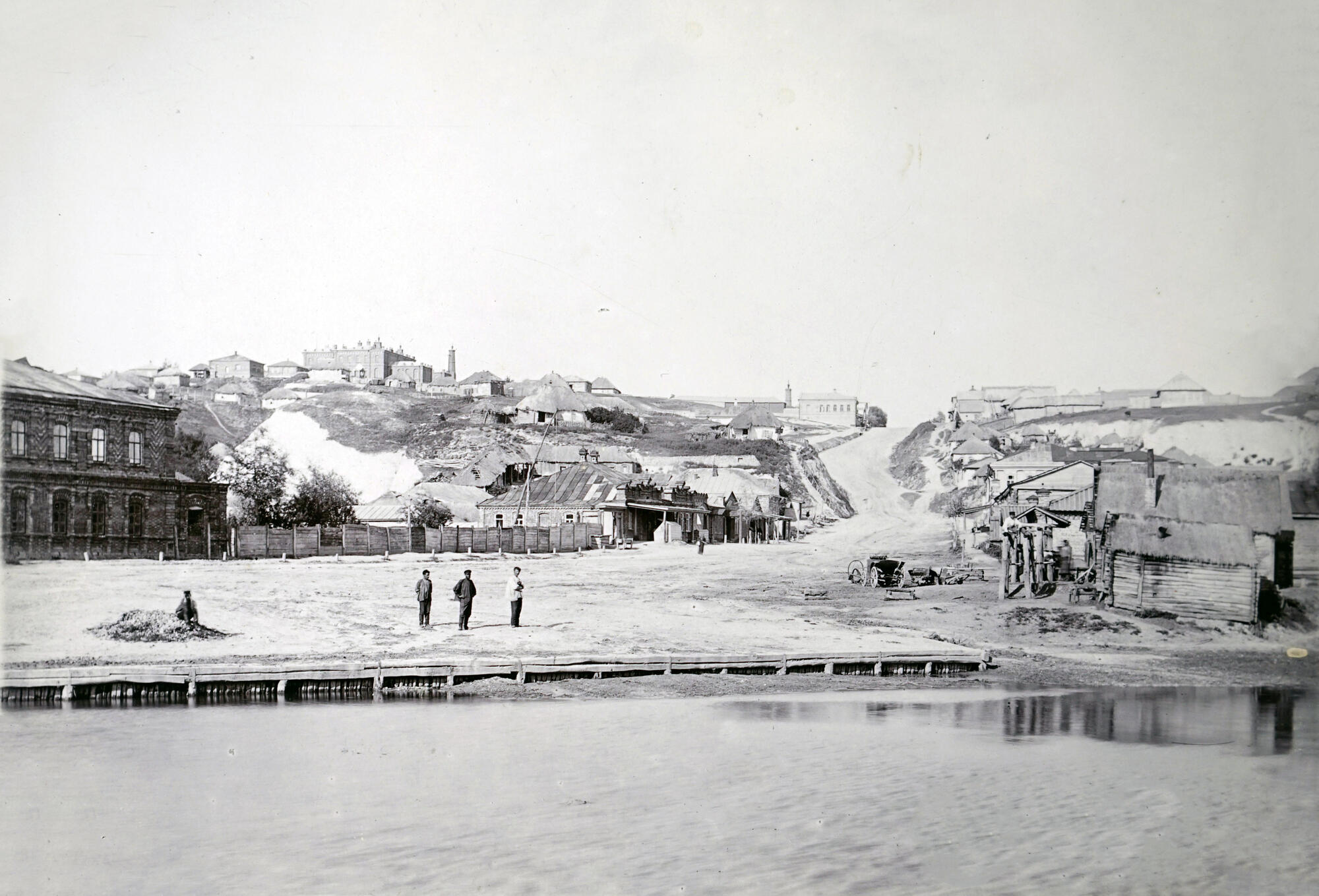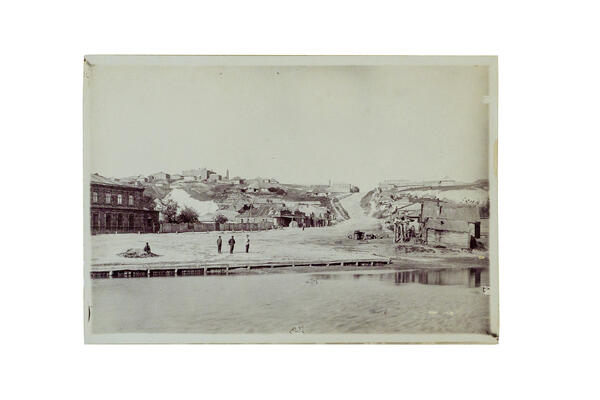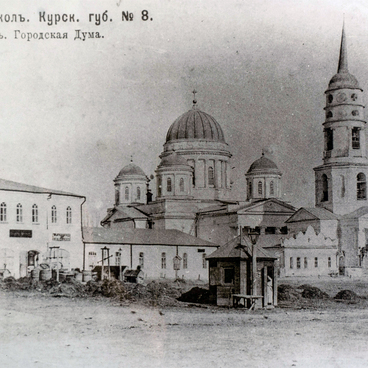The photo shows a view of Belgorodskaya Street (now Komsomolsky Avenue) from the south-west. In the foreground is the Oskolets river with the pier. In the center is the running down Belgorodskaya Street, with the town buildings in the background.
Belgorodskaya street is one of the oldest and main streets of the city. It was home to a district hospital, a vocational school, the Russo-Asian Bank, the house of the Noble Assembly, the Church of the Intercession of the Blessed Virgin Mary, the Yakovlev grocery shop, the house and shop of the Povolyaev merchants, and many residential buildings. The descent to Oskolets river along Belgorodskaya street was called Gumenskaya hill. This was related to the fact, that the descent connected the town with the Gumny settlement, separated by the Oskolets river. The Gumny settlement was first mentioned in archival documents for 1720.
The road, near the bridge over the Oskolets river, was the location of household and commercial buildings and the town’s public baths. In the same area there were also barnyards — “gumno”, which gave the settlement its name. A special attraction and source of pride of the settlement was a well-equipped pier. The wooden quay was used to berth loaded boat, unload grain, hemp, leather, and pottery.
The theological school was formed in the first quarter of the 19th century and was first located in several houses on Belgorodskaya Street. In 1888, a special building with a chapel inside began to be built. It was opened in 1900. The new building had a complex design. The windows on the ground floor were tall and arched. The front entrance to the school was crowned with a unique wrought iron awning made by blacksmiths from Stary Oskol, Lanin brothers. Domes, superstructures, turrets decorated the roof of the building. The students of the theological school were forbidden to visit cinemas, theaters, confectionaries and other entertainment places, including promenade and railway platforms.
After the events of October 1917, as early as December 6, 1917, a joint meeting of the Presidiums of the Soviets of Workers’ and Peasants’ Deputies was held there. In the following years, the building has been used by various institutions mainly as a cultural and leisure center. On January, 28, 1942 the Guards banner was handed over to the 2nd Taman Rifle Division named after M. I. Kalinin in the square in front of the building. The division was staying at Stary Oskol for restructuring after severe battles near Moscow.
Belgorodskaya street is one of the oldest and main streets of the city. It was home to a district hospital, a vocational school, the Russo-Asian Bank, the house of the Noble Assembly, the Church of the Intercession of the Blessed Virgin Mary, the Yakovlev grocery shop, the house and shop of the Povolyaev merchants, and many residential buildings. The descent to Oskolets river along Belgorodskaya street was called Gumenskaya hill. This was related to the fact, that the descent connected the town with the Gumny settlement, separated by the Oskolets river. The Gumny settlement was first mentioned in archival documents for 1720.
The road, near the bridge over the Oskolets river, was the location of household and commercial buildings and the town’s public baths. In the same area there were also barnyards — “gumno”, which gave the settlement its name. A special attraction and source of pride of the settlement was a well-equipped pier. The wooden quay was used to berth loaded boat, unload grain, hemp, leather, and pottery.
The theological school was formed in the first quarter of the 19th century and was first located in several houses on Belgorodskaya Street. In 1888, a special building with a chapel inside began to be built. It was opened in 1900. The new building had a complex design. The windows on the ground floor were tall and arched. The front entrance to the school was crowned with a unique wrought iron awning made by blacksmiths from Stary Oskol, Lanin brothers. Domes, superstructures, turrets decorated the roof of the building. The students of the theological school were forbidden to visit cinemas, theaters, confectionaries and other entertainment places, including promenade and railway platforms.
After the events of October 1917, as early as December 6, 1917, a joint meeting of the Presidiums of the Soviets of Workers’ and Peasants’ Deputies was held there. In the following years, the building has been used by various institutions mainly as a cultural and leisure center. On January, 28, 1942 the Guards banner was handed over to the 2nd Taman Rifle Division named after M. I. Kalinin in the square in front of the building. The division was staying at Stary Oskol for restructuring after severe battles near Moscow.



